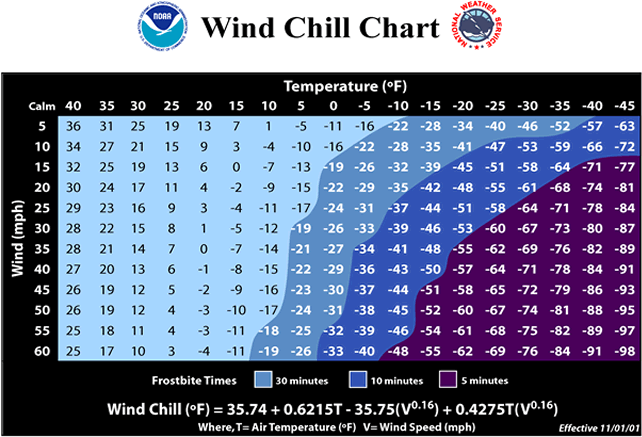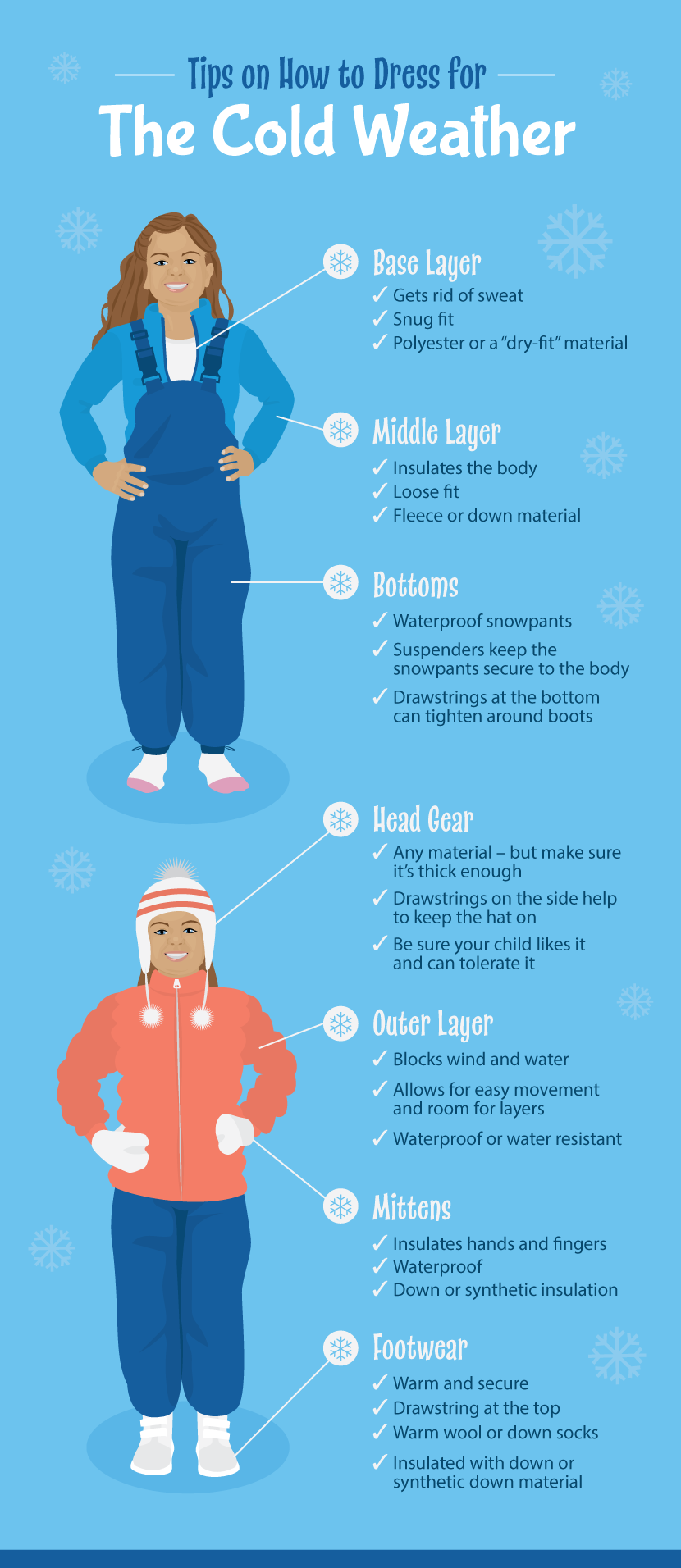Too Cold for School?
Posted in Accident & Injury on February 10, 2017
School officials have no problem justifying a delay or cancellation when roads are covered in snow or ice, but making the decision to cancel when low wind chill values are the issue at hand can be much harder. While some children are cozy in the back of a parent’s vehicle during their commute, many of their peers walk to school or a bus stop each day. This contrast in circumstances raises a question commonly debated by both parents and administrators: how cold is too cold for school?
What is wind chill?
Wind chill is calculated using air temperature and wind speed. The resulting value indicates how cold the air feels on bare skin, not the actual temperature. For example, an outside temperature of 0°F feels like -19°F when combined with 15 mph winds. Air feels much colder when it is moving quickly, and heat is carried away from the body at a faster rate as wind speeds increase. Skin temperature and internal body temperature can both drop significantly if a person is outside without the proper attire when wind chill values are low.

Chart courtesy of the National Weather Service.
The National Weather Service commonly issues the following types of alerts in areas affected by dangerously cold weather:
Wind Chill Advisory: Alerts the community that seasonably cold weather is expected. Those who choose to go outside should dress appropriately and exercise caution.
Wind Chill Watch: Raises awareness about the potential for dangerously low wind chill values and encourages those in the affected area to be prepared.
Wind Chill Warning: Affected area is experiencing or will likely experience dangerously low wind chill values. Community members should plan ahead and avoid going outside if possible.
The conditions worthy of these alerts reflect regional climate differences and vary from state to state. According to the Ohio Committee for Severe Weather Awareness, a Wind Chill Advisory is issued when wind chill temperatures are expected to reach 10 to 24 degrees below zero (20 to 29 degrees below zero in extreme northwest Ohio). Wind Chill Warnings are issued for dangerous, life-threatening wind chills of -25°F or colder (-30°F in extreme northwest Ohio). A Wind Chill Watch may be issued 12 to 48 hours before dangerous wind chill values are expected to occur.
How cold is too cold for school?
There are no national or state guidelines for weather-related school closings and delays, so district administrators must evaluate a variety of factors when determining the best course of action. Student attendance requirements, transportation challenges, health hazards, safety risks and the condition of school buildings can all play a role in the decision. Parents’ ability to find childcare with little notice and the level of food insecurity are also taken into consideration in some districts.
In 2014, Ohio replaced the minimum number of days in a school year with a minimum number of hours. The law applies to state school districts, joint vocational school districts and chartered nonpublic schools, and the requirements vary by grade level. At least 455 hours of instruction are required for half-day kindergartens, 910 hours for all-day kindergartens and elementary schools, and 1,001 hours for grades seven through 12. Many school districts schedule a greater number of hours than required into their academic calendars to plan ahead for weather-related closings and delays.
Health Concerns
Winter winds and cold weather may seem less threatening than slick roads, but these invisible dangers can pose serious health risks to anyone who ventures outside. As wind chill values drop, heat is drawn away from the body more quickly and the risk of suffering frostbite or hypothermia rapidly increases.
Frostbite
What is frostbite?
Frostbite occurs when skin and underlying tissue freeze. The condition affects the top layers of the skin in its early stages, and can progress through to the muscles and bones if it becomes severe. Mild symptoms may be treated with first-aid measures, but medical attention is often required in more serious cases.
What are the warning signs?
- Cold skin with prickling sensation
- Discolored skin (often red or abnormally pale)
- Numbness
- Hard skin with waxy appearance
- Blistering
Covered skin can develop frostbite in extreme cold or if an article of clothing is wet, so pay attention to both exposed and unexposed areas.
How should frostbite be treated?
Go inside immediately if you notice symptoms of frostbite. Gently rewarm affected areas, and seek medical attention if your skin is abnormally pale or if you experience numbness or blisters.
How can you prevent frostbite?
Your fingers, toes, nose, ears, cheeks and chin are most vulnerable to frostbite, so be sure these areas are covered before going outside. Wet clothing, hats, mittens and socks can cause frostbite to develop more quickly. Change or go inside as soon as possible if your gear becomes damp.
Hypothermia
What is hypothermia?
Hypothermia develops when the body loses heat faster than it can be produced and the internal body temperature falls below 95°F. The condition can be fatal or cause permanent organ damage if it is not quickly identified and treated.
What are the symptoms?
- Uncontrollable shivering
- Disorientation
- Incoherence
- Slurred speech
- Drowsiness
- Apparent exhaustion
- Memory loss
How should hypothermia be treated?
If you suspect a person is suffering from hypothermia take their temperature as soon as possible. Seek immediate medical attention if their temperature is below 95°F and attempt to slowly warm up the person, starting with their body core.
How can you prevent hypothermia?
To avoid hypothermia, Mayo Clinic recommends following the advice associated with the acronym COLD – cover, overexertion, layers, dry. Learn the related prevention tips.
Dressing for the Weather
Children can face risks associated with dangerously cold temperatures even on days when the weather isn’t quite bad enough for school to be cancelled. Whether your little ones are walking to school, waiting at the bus stop or heading outside to play, be sure they’re dressed appropriately.
Follow these tips to protect your children when low wind chill values are in the forecast:
- Children should be dressed in multiple layers of warm, lightweight clothing, and should typically wear one more layer than an adult would wear under the same conditions.
- Prevent heat loss through your child’s head with a hat or hood, and cover their mouth with a scarf to protect their lungs.
- Take extra caution when it comes to fingers, toes and other extremities prone to frostbite.
- Mittens (or “glittens”) are better at protecting hands from the cold than gloves. Choose a pair that is banded at the wrist.
- Coats, boots, hats and mittens should be insulated and water-repellant.
- Keep an extra set of clothes, socks and shoes in your car and at your child’s school in case their original outfit becomes damp.

Source: Fix.com Blog
The dangers of low wind chill values are easy to overlook, especially when there’s no snow on the ground, but these hazards should be taken just as seriously as other winter weather conditions. Take the proper precautions to protect your children, your pets and yourself, and remember to check on elderly neighbors and loved ones.
How cold is too cold for school? Share your thoughts in the comments.